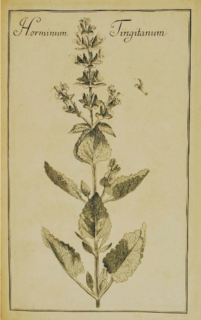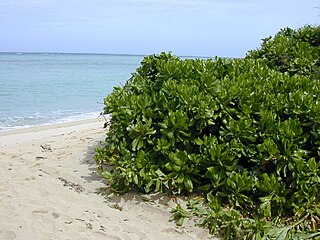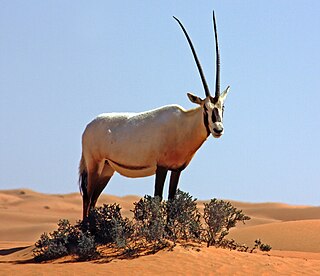
Ferula is a genus of about 220 species of flowering plants in the family Apiaceae, native to the Mediterranean region east to central Asia, mostly growing in arid climates. They are herbaceous perennial plants growing to 1–4 m tall, with stout, hollow, somewhat succulent stems. The leaves are tripinnate or even more finely divided, with a stout basal sheath clasping the stem. The flowers are usually yellow, rarely white, produced in large umbels. Many plants of this genus, especially F. communis, are referred to as "giant fennel," although they are not fennel in the strict sense.

Peganum harmala, commonly called wild rue, Syrian rue, African rue, esfand or espand, or harmel, is a perennial, herbaceous plant, with a woody underground root-stock, of the family Nitrariaceae, usually growing in saline soils in temperate desert and Mediterranean regions. Its common English-language name came about because of a resemblance to rue. Because eating it can cause livestock to sicken or die, it is considered a noxious weed in a number of countries. It has become an invasive species in some regions of the western United States. The plant is popular in Middle Eastern and north African folk medicine. The alkaloids contained in the plant, including the seeds, are monoamine oxidase inhibitors.

Avicennia marina, commonly known as grey mangrove or white mangrove, is a species of mangrove tree classified in the plant family Acanthaceae. As with other mangroves, it occurs in the intertidal zones of estuarine areas.

Banksia ilicifolia, commonly known as holly-leaved banksia, is a tree in the family Proteaceae. Endemic to southwest Western Australia, it belongs to Banksia subg. Isostylis, a subgenus of three closely related Banksia species with inflorescences that are dome-shaped heads rather than characteristic Banksia flower spikes. It is generally a tree up to 10 metres (33 ft) tall with a columnar or irregular habit. Both the scientific and common names arise from the similarity of its foliage to that of the English holly Ilex aquifolium; the glossy green leaves generally have very prickly serrated margins, although some plants lack toothed leaves. The inflorescences are initially yellow but become red-tinged with maturity; this acts as a signal to alert birds that the flowers have opened and nectar is available.

Banksia serrata, commonly known as the saw banksia, the old man banksia, the saw-tooth banksia or the red honeysuckle and as wiriyagan by the Cadigal people, is a species of woody shrub or tree of the genus Banksia, in the family Proteaceae. Native to the east coast of Australia, it is found from Queensland to Victoria with outlying populations on Tasmania and Flinders Island. Commonly growing as a gnarled tree up to 16 m (50 ft) in height, it can be much smaller in more exposed areas. This Banksia species has wrinkled grey bark, shiny dark green serrated leaves and large yellow or greyish-yellow flower spikes appearing over summer. The flower spikes, or inflorescences, turn grey as they age and pollinated flowers develop into large, grey, woody seed pods called follicles.

Banksia marginata, commonly known as the silver banksia, is a species of tree or woody shrub in the plant genus Banksia found throughout much of southeastern Australia. It ranges from the Eyre Peninsula in South Australia to north of Armidale, New South Wales, and across Tasmania and the islands of Bass Strait. It grows in various habitats, including Eucalyptus forest, scrub, heathland and moorland. Banksia marginata varies widely in habit, ranging from a 20-centimetre (7.9 in) shrub to a 12-metre (40 ft) tree. The narrow leaves are linear and the yellow inflorescences occur from late summer to early winter. The flower spikes fade to brown and then grey and develop woody follicles bearing the winged seeds. Originally described by Antonio José Cavanilles in 1800, further collections of B. marginata were designated as several separate species by Robert Brown in 1810. However, all were reclassified as a single species by George Bentham in 1870. No distinct subspecies have been recognised by Banksia expert Alex George, who nonetheless concedes that further work is needed.

Banksia speciosa, commonly known as the showy banksia, is a species of large shrub or small tree in the family Proteaceae. It is found on the south coast of Western Australia between Hopetoun (33°57′ S) and the Great Australian Bight, growing on white or grey sand in shrubland. Reaching up to 8 m (26 ft) in height, it is a single-stemmed plant that has thin leaves with prominent triangular "teeth" along each margin, which are 20–45 cm (7.9–17.7 in) long and 2–4 cm (0.8–1.6 in) wide. The prominent cream-yellow flower spikes known as inflorescences appear throughout the year. As they age they develop up to 20 follicles each that store seeds until opened by fire. Though widely occurring, the species is highly sensitive to dieback and large populations of plants have succumbed to the disease.
Banksia montana, commonly known as the Stirling Range dryandra, is a species of shrub that is endemic to the Stirling Range in Western Australia. It has hairy stems, linear pinnatisect leaves with twisted, triangular lobes, yellow flowers in heads of about sixty and reddish-brown follicles.

Malva sylvestris is a species of the mallow genus Malva in the family of Malvaceae and is considered to be the type species for the genus. Known as common mallow to English-speaking Europeans, it acquired the common names of cheeses, high mallow and tall mallow as it migrated from its native home in Western Europe, North Africa and Asia through the English-speaking world.

Adenanthos obovatus, commonly known as basket flower, or, jugflower, is a shrub of the plant family Proteaceae endemic to Southwest Australia. Described by French naturalist Jacques Labillardière in 1805, it had first been collected by Archibald Menzies in 1791. Within the genus Adenanthos, it lies in the section Eurylaema and is most closely related to A. barbiger. A. obovatus has hybridized with A. detmoldii to produce the hybrid A. × pamela. Several common names allude to the prominent red flowers of the species. It grows as a many-stemmed spreading bush up to 1 m (3.3 ft) high, and about 1.5 m (4.9 ft) across, with fine bright green foliage. Made up of single red flowers, the inflorescences appear from April to December, and peak in spring.

Salvia tingitana is an herbaceous perennial in the family Lamiaceae. It has a long and enigmatic history—it has been grown and described since the 17th century without any certainty about its origin. Botanists' speculation that it was native to northern Africa is reflected in the specific epithet tingitana, which refers to the town of "Tingi", even though no native plants have ever been found there. It was not until 1989 that a wild population of the plant was discovered, in western Saudi Arabia.
Adenanthos ileticos is a species of shrub in the family Proteaceae. It has roughly triangular, lobed leaves, and pale pink-red and cream, inconspicuous flowers. A rare species, it is known only from a single location in the south-west of Western Australia. It was discovered in 1968, and immediately brought into cultivation, but it would not be formally published and named until a decade later.

Reichardia is a genus of plants in the tribe Cichorieae within the family Asteraceae native to the Mediterranean and western Asia. In Crete, Greece the leaves and tender shoots of a variety of Reichardia picroides called galatsida (γαλατσίδα) are eaten raw, boiled, cooked in steam or browned with olive oil by the locals. Brighteyes is a common name for plants in this genus.

Persoonia levis, commonly known as the broad-leaved geebung, is a shrub native to New South Wales and Victoria in eastern Australia. It reaches 5 m (16 ft) in height and has dark grey papery bark and bright green asymmetrical sickle-shaped leaves up to 14 cm (5.5 in) long and 8 cm (3.2 in) wide. The small yellow flowers appear in summer and autumn, followed by small green fleshy fruit, which are classified as drupes. Within the genus Persoonia, it is a member of the Lanceolata group of 58 closely related species. P. levis interbreeds with several other species where they grow together.
Adenanthos eyrei is a species of shrub in the family Proteaceae. Restricted to a single cliff-top dune system on the remote south coast of Western Australia, it is listed as rare and endangered. It was discovered by E. Charles Nelson in 1973, and formally described and named in 1978.

Scaevola taccada, also known as beach cabbage, sea lettuce, beach naupaka, naupaka kahakai (Hawaiian), magoo (Divehi), merambong (Malay), bapaceda or papatjeda, ngahu (Tongan) is a flowering plant in the family Goodeniaceae found in coastal locations in the tropical areas of the Indo-Pacific. It is a common beach shrub throughout the Arabian Sea, the tropical Indian Ocean and the tropical islands of the Pacific Ocean.

Suaeda aegyptiaca is a species of succulent plant in the family Amaranthaceae, and salt-tolerant (halophyte) plant that is distributed in eastern North Africa, the Near East and West Asia.

The wildlife of Qatar includes the peninsula's flora and fauna and their natural habitats. The country's terrestrial wildlife includes numerous small nocturnal mammals, a number of reptiles which mainly consist of lizard species, and arthropods. Aquatic animals primarily include fish, shrimp and pearl oysters. The desert and the shoreline form an important resting site for a number of migratory bird species during autumn and spring. Urban and agricultural developments have led to an increase in bird species.

The flora of Qatar includes more than 300 species of wild plants. Qatar occupies a small desert peninsula that is around 80 km from east to west and 160 km from north to south. The climate is hot and humid with sporadic rain. Majority of the country is flat with an annual rainfall average of less than 3 inches. Arnebia hispidissim blooms yellow flowers annually in sandy soil. Glossonema edule has edible fruits with brownish-yellow flowers.

Persoonia terminalis, also known as the Torrington geebung, is a shrub belonging to the family Proteaceae, and native to northern New South Wales and southern Queensland in eastern Australia. Reported as a subspecies of Persoonia nutans in 1981, it was described as a species by Lawrie Johnson and his colleague Peter Weston in 1991.




















